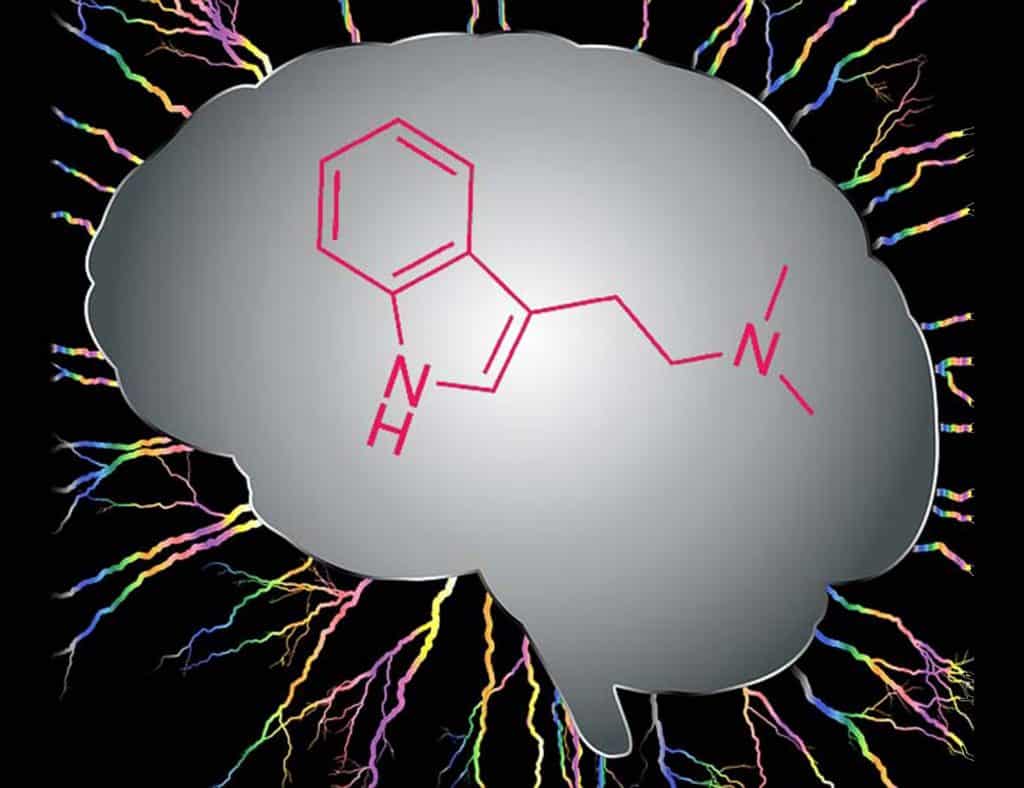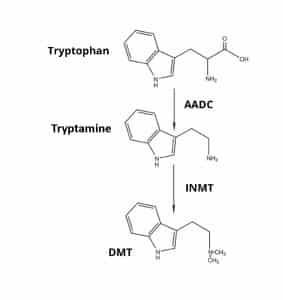Pineal Gland DMT – What the Science Says

It’s one of the most widely-shared and well-known statements in psychedelia: “DMT is made in the pineal gland.”
DMT is often an ingredient of the psychedelic brew ayahuasca, and it can also be smoked or ingested on its own. It is known for producing intense, potentially life-changing visions and experiences.
The pineal gland is a tiny organ in the brain that makes melatonin, a hormone that helps us go to sleep. It’s also the part of the brain that people think could be making DMT.
You’ve probably heard people claim that DMT is released in the human brain at death, or during religious encounters, and that DMT is the chemical that brings us in touch with our soul even when we haven’t taken any substances.
So what’s the evidence? Is DMT really made in the pineal gland of our brains?
Who Came Up with the DMT in the Pineal Gland Idea First?
Pretty much as soon as its hallucinogenic effects of DMT were discovered in the 1950s, scientists suspected that it might be present in human brains (Barker, 2018). This sparked a series of studies into the presence of DMT, mostly in rodents. Promising preliminary research led famous psychedelic researcher Rick Strassman to propose that DMT was made by the pineal gland in humans; a speculation that was popularized in the 2010 movie “DMT: The Spirit Molecule.”
The pineal gland has long been popular. The philosopher Descartes wrote in the 1600s that the pineal gland was “the principal seat of the soul and the place in which all our thoughts are formed.” Since then, the idea that the pineal gland is the mystical ‘third eye’ mentioned in many Eastern religions has grown in popularity.
Rick Strassman thought the pineal gland could be producing DMT partly because of its mystical links to the ‘third eye,’ and partly because he knew it was capable of producing the hormone melatonin, which is a similar biological process to the synthesis of DMT.
Strassman’s idea was infectious. It was an exciting thought to imagine that the pineal gland possessed machinery capable of flooding our bodies with psychedelic molecules; and that we could potentially take control of it and catapult ourselves into spiritual bliss at will!
It’s still a concept that is widespread throughout the psychedelic community, and many simply accept it as fact. The idea of DMT occurring naturally in the brain makes so much sense to people who’ve tripped on it, that they’re happy to accept it without paying too much attention to the evidence.
Even this month, a new wave of media attention surrounding a recent study on DMT peaked with headlines like “Psychedelic Compound DMT Officially Discovered in Human Brain,” and “Brain Naturally Produces Powerful Psychedelic Compound DMT.”
But this, and other studies, have been misinterpreted. In fact, the claim that DMT exists in the human brain has still never been scientifically proven – but there is a lot of evidence to suggest that it’s possible.
Some Mammals Definitely Have the Machinery to Make DMT in the Pineal Gland
The first important discoveries about the potential presence of DMT in the mammalian brain are concerning an enzyme called indole-N-methyltransferase (INMT). This is an enzyme that is capable of generating DMT from tryptamine, which is a molecule found in small amounts in many plants and animals.
If scientists could show that INMT was present in significant quantities in the brain, this would be the first step in figuring out if DMT really was hanging out in our heads.
INMT was discovered in the rat brain in the 1960s (Axelrod, 1961). In 1972, scientists found for the first time that the rat brain was capable of converting tryptamine into DMT, when large quantities of tryptamine were injected directly into the brain (Saavedra & Axelrod, 1972). It looked like INMT was capable of producing DMT in the rat brain.
INMT was also found in several parts of the brain of the chick (Morgan & Mandell, 1969) and monkey (Cozzzi et al, 2011), including in the pineal gland. So it was looking more convincing that the brains of several animals had the means to make DMT.
But it’s not just INMT that’s needed to produce DMT. The availability of tryptamine is probably the limiting factor. Tryptamine is what INMT uses to make DMT, and is present in very small levels in the human brain, and gets quickly degraded by monoamine oxidases (MAOs).
Tryptamine is created from tryptophan (an essential building block of life) by the enzyme aromatic L-amino acid decarboxylase (AADC). This means that researchers are now starting to focus on finding these two enzymes, INMT and AADC, together in close proximity. If they’re both there, it’s possible they’re producing DMT together.
So Has DMT Itself Been Found in Mammalian Brains?
Even if INMT and AADC are found together in the brain, that doesn’t necessarily mean that DMT is being made, or that it’s possible for it to be made in high enough quantities to make us trip.
Before this year, DMT has been found in small quantities in the rat pineal gland (Barker et al, 2013) and throughout the entire rat brain (Beaton & Morris, 1984). But we didn’t know if it was at high enough levels to actually make a difference.
This was all changed earlier this year, when research was released that showed DMT was present in the rat brain, at levels as high as crucial neurotransmitters like serotonin (Dean et al, 2019).
They also found that when these rats were forced into a cardiac arrest, DMT levels spiked in the visual areas of the rat brain. This could be the fabled near-death experience that DMT is thought to contribute to.
Interestingly, rats with or without a pineal gland produced the same amount of DMT, suggesting that DMT was probably being produced throughout the nervous system (Dean et al, 2019).
Is It the Same for Humans?
The furthest we’ve got along this pathway, in terms of humans, is a recent study that showed the presence of the INMT enzyme in human brains (Dean et al, 2019). Although we also know that humans have the AADC enzyme, we unfortunately don’t know if it exists near INMT; that would be the next step in the investigation.
There have been several studies that have looked at DMT levels in human cerebrospinal fluid, a bodily fluid that protects the brain. However, none of these studies figured out how much DMT was present (summarised in Barker, 2018), so we still don’t know if the human brain is capable of making large amounts of DMT like the rat brain can (Dean et al, 2019).
DMT is Probably in Our Brains – But Does It Make a Difference?
We now know that rats are capable of producing large quantities of DMT, and that humans could potentially do it too.
Interestingly, there is mixed evidence about the role of the pineal gland. Some studies have found DMT in pineal glands of mammals, but the most recent study found that rats didn’t need a pineal gland to make DMT.
To be absolutely clear, there is still no conclusive evidence that DMT exists naturally in the human brain, at levels that could have a psychological effect.
The next step is for scientists to actually detect DMT in the human brain for the first time, and perhaps show that it can be produced in high enough levels to actually alter our conscious perception.
Then we can prove that DMT’s nickname, “The Spirit Molecule,” is truly deserved.
For a review of the research into DMT, and for further details on the topics discussed in this article, see this paper by Steven Barker.
References
Axelrod, J (1961). Enzymatic formation of psychotomimetic metabolits from normally occurring compounds. Science 134, p.343-344.
Barker SA, Borjigin J, Lomnicka I & Strassman R (2013). LC/MS/MS analysis of the endogenous dimethyltryptamine hallucinogens, their precursors, and major metabolites in rat pineal gland microdialysate. Biomed Chromatogr 27, p.1690-1700.
Beaton JM & Morris PE (1984). Ontogeny of N,N-dimethyltryptamine and related indolealkylamine levels in neonatal rats. Mech Ageing Dev 25, p.343-347.
Cozzi NV, Mavlyutov TA, Thompson MA & Ruoho AE (2011). Indolethylamine-N-methyltransferase expression in primate nervous tissue. Abstr Soc Neurosci 37, 840.19.
Dean JG, Liu T, Huff S, Sheler B, Barker SA, Strassman RJ, Wang MM & Borjigin J (2019). Biosynthesis and Extracellular Concentrations of N,N-dimethyltryptamine (DMT) in Mammalian Brain. Sci Rep 9, 9333.
Morgan M & Mandell AJ (1969). Indole(ethyl)amine N-methyltransferase in the brain. Science 165, p.492-493.
Saavedra JM & Axelrod J (1972). Psychotomimetic N-methylated tryptamines: formation in brain in vivo and in vitro. Science 175, p.1365-1366.
Saveedra JM, Coyle JT & Axelrod J (1973). The distribution and properties of the non-specific N-methyltransferase in brain. J Neurochem 20, p.743-752.



Thank you! This is the clearest explanation I’ve found so far.
Patrick, you’ve provided a real contribution to my understanding with this article. Mnay thanks.
As researchers probe the possible pineal-DMT connection, I hope they take into account the fact that fluoride calcifies the pineal gland, inhibiting its various functions. Bio-soluble curcumin which can pass through the blood-brain barrier can detoxify the pineal gland from its fluoride burden.